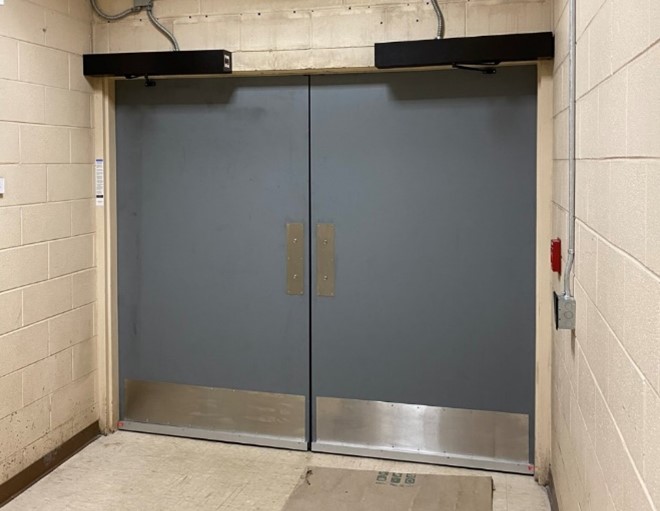Demonstration Overview
 The DoD STED Program demonstrated sustainable door systems for use in facilities at Department of Defense (DoD) Installations.
The DoD STED Program demonstrated sustainable door systems for use in facilities at Department of Defense (DoD) Installations.
Although doors for residential buildings are designated for Federal procurement preference under the Energy Star Program, the vast majority of DoD facilities are commercial rather than residential. This demonstration evaluated insulated interior and exterior door systems for commercial buildings that offer improved energy efficiency compared to traditional hollow metal doors.
 Conventional building doors for both interior and exterior door applications are sources of energy loss due to air leaks and low insulation properties. In addition, conventional doors with entry control system and automated door openers are not energy efficient. A sustainable door system was identified that provides energy savings from both insulating properties and electrical power consumption. It is constructed of recycled content materials and provides energy savings from both insulating properties and electrical power consumption. The door system components are evaluated from a life cycle perspective and save energy due to improved insulation and intelligent control of various door opening solutions. The door system supports meeting various criteria in third-party green building certifications.
Conventional building doors for both interior and exterior door applications are sources of energy loss due to air leaks and low insulation properties. In addition, conventional doors with entry control system and automated door openers are not energy efficient. A sustainable door system was identified that provides energy savings from both insulating properties and electrical power consumption. It is constructed of recycled content materials and provides energy savings from both insulating properties and electrical power consumption. The door system components are evaluated from a life cycle perspective and save energy due to improved insulation and intelligent control of various door opening solutions. The door system supports meeting various criteria in third-party green building certifications.
Sustainable door systems provide both performance and environmental benefits including:
- Reduced thermal heat transmission
- Reduced drafts and air seepage
- Reduction in electrical usage
- Reduced sound/noise transmission
- Increased use of recycled content and sustainable materials
- Reduced VOC off-gassing
- Contribution to building LEED ratings
- Enhanced security and access control
- Reliable and consistent door closing and locking
Before such door systems are utilized by the Military Departments and DoD Components, their performance must be proven to meet DoD requirements.
Demonstration Products*
The following sustainable door system products were demonstrated:
- Ceco Trio-E 777E door system by ASSA ABLOY.
*Mention of or referral to commercial products, services, and manufacturers herein is provided for informational purposes only and does not constitute endorsement by, nor the official policy or position of, the Department of Defense (DoD), any of its Components, or the U.S. Government.
Demonstration Sites
Field demonstrations of these products were performed at the following DoD installations to evaluate their performance in Military operational environments and to raise awareness of more energy efficient product availability:
- Redstone Arsenal
- Marine Corps Base Quantico
- Joint Base San Antonio (JBSA)
- Fort Bragg
Demonstration Details
A sustainable door system demonstration plan was developed to outline the demonstration activities to be performed, identify site performance requirements and the key performance criteria, as well as select the sustainable door systems to be evaluated. Energy efficient door systems were installed at the participating sites and end users were asked to provide feedback on the product performance. Table 1 contains the key performance criteria that the DoD stakeholders established to evaluate and validate that the installed door systems met the participants’ requirements.
Table 1: Demonstration Performance Criteria
| Criteria | Parameters |
|---|---|
| Door functionality |
|
| Insulating/thermal properties and air drafts |
|
| Odor/fume containment |
|
Demonstration Results
The participating facility personnel at the listed installations found the sustainable door systems to be an acceptable alternative to their currently used door systems. In addition to being third-party certified for recycled content and low interior emissions, International Living Future Institute (ILFI) Red List compliant, and manufactured domestically using renewable energy, the door systems exceeded operational and durability performance requirements at participating sites and exceeded the identified key performance criteria as follows:
- The thermal efficiency of the demonstration door systems is significantly greater than the baseline door systems, greatly reducing energy loss through the doors. The demonstrated door systems have a U-Factor of 0.36, which is 25% lower than the Unified Facilities Guide Specifications (UFGS) 08 11 13 (Steel Doors and Frames) recommended U-Factor of 0.48, resulting in increased thermal insulation properties and reduced thermal transmittance.
- The demonstration door systems opened and closed satisfactorily without performance issues during manual and automated operation.
- The demonstration door systems are durable and have not required component repairs.
- The existing building access controls and door actuators perform satisfactorily without issues with the demonstration door systems.
- The demonstration door systems eliminated air drafts and odor/fume transmission through the doors that were present with the baseline doors.
A third-party analysis of demonstration results certified that the demonstrated door systems yielded a significant energy savings compared to the baseline doors. This third-party analysis certified an energy savings of 67 to 99 percent in direct comparison to the existing door systems being replaced (measured using thermal readings).

Based on the energy efficiency findings, the DoD STED Program calculated a potential to reduce energy consumption by 1.8 million megawatt hours per year and electricity costs by $170 million per year if energy efficient door systems are adopted DoD-wide.


